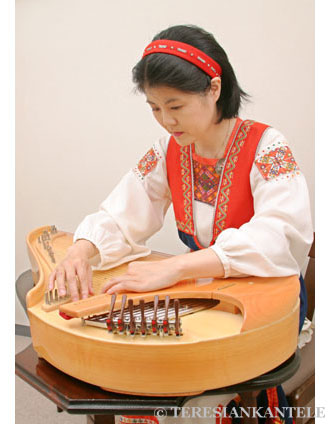
Once was a Japanese koto-master, Masako Hazata, fascinated by kantele's sensitive and ethereal tone, took part in the kantele summer camp in Lahti, Finland in 1985. At the Sibelius-Academy in Helsinki, she studied 39-string concert kantele under Ritva Koistinen in 1988. By joining Annikki Smölander- Hauvonen's leading kantele group, "Käenpiika", she started her career as a kantele player. Hazata performed at a number of concerts in Finland, and she also toured Japan with them in 1992. She was very privileged to perform for the pope in Rome during Easter, 1991. Her interests also extended to Fin nish folk music and she studied 5-string kantele under Minna Raskinen at the Sibelius Academy.
After returning to Japan in 1994, Hazata has worked to promote kantele and Finnish culture through her performances mainly in Tokyo, and also emphasis on the education of kantele players in Japan.
In 1998, her first, and also the first by a Japanese kantele player, album "KANTELE" was released on San Paolo. She appeared on the NHK(Japanese broadcasting company) programs, "Music Beat(ミュージックビート)" in 1999 and "Radio Evening Newspaper(ラジオ夕刊)" in 2004. Her activities are not limited to performing as a soloist. She collaborated with an Ocarina player, Sojiro, in his CD "The Orion", "Duet". She played in "The Harambee Endowment Concert 2002" in Rome. She had her second CD, all original collections, "KANTELEⅡ" in 2003. She also had the honor to perform for her Majesty the Empress in 2004.
Ms Hazata has kept working constantly in recent years too. She played at the music festival "La Folle Journée au Japan-Days of Enthusiasm 2007". And her 3rd album "KANTELE Christmas" was released in 2007. Also Two collaboration CDs with Masahiko Sugiyama "Meguriai-(Fortune)" , with Minoru Chiba "kantele & ocarina" were released in 2008 and 2010, and she took part in a compilation album "The Forest of Healing FINLAND", in 2014. In 2017, she appeared on the BSJapan TV-program "Music intersection (音楽交差点)", in 2019 on the NHK radio program "Recital passio(リサイタル・パッシオ)".
Masako Hazata is a leading kantele player in Japan.
My Space:You can listen to some Masako Hazata's original tunes.


